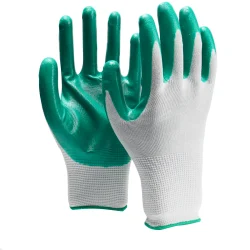The Essential Guide to Choosing the Perfect Garden Gloves
2024-09-21
Gardening is a relaxing and rewarding activity, but it can also take a toll on your hands. Whether you're pulling weeds, planting flowers, or pruning bushes, a good pair of garden gloves is essential for protecting your skin and making the work more comfortable. In this blog post, we'll explore the different types of garden gloves, what to look for when choosing a pair, and how the right gloves can make all the difference in your gardening experience.
1. Why Are Garden Gloves Important?
Gardening gloves are more than just a fashion accessory; they serve a practical purpose. Here's why you should always wear them:
- Protection from Thorns and Splinters: Many plants, like roses or cacti, have sharp thorns that can easily puncture your skin. Gloves protect your hands from these hazards.
- Prevention of Blisters and Calluses: Repeated movements like digging and raking can cause friction, leading to blisters and rough skin. Garden gloves provide a cushion that reduces friction.
- Keeping Your Hands Clean: Working with soil can leave your hands dirty and your nails packed with dirt. Gloves help you avoid this mess and make clean-up easier.
- Chemical Protection: If you use fertilizers, pesticides, or herbicides in your garden, gloves act as a barrier, keeping harmful substances off your skin.
2. Different Types of Garden Gloves
Garden gloves come in a variety of styles and materials, each designed for specific gardening tasks. Here are the most common types:
- Leather Gloves: Durable and tough, leather gloves are ideal for heavy-duty gardening tasks like pruning thorny plants or handling rough tools. They offer excellent protection from sharp objects but may not be as breathable as other materials.
- Rubber or Nitrile-Coated Gloves: These gloves are water-resistant and perfect for working in wet conditions or handling chemicals. The coating provides excellent grip, making them ideal for tasks like planting or watering.
- Cotton Gloves: Lightweight and breathable, cotton gloves are perfect for light gardening tasks like planting seeds or pulling small weeds. They're comfortable to wear but don't provide much protection from thorns or sharp tools.
- Cloth Gloves with Rubberized Palms: These gloves combine the comfort of cloth with the protection and grip of rubber. They're versatile, suitable for a range of tasks, and often come with extra features like reinforced fingertips for durability.
3. How to Choose the Right Garden Gloves
When selecting garden gloves, consider the following factors to ensure you get a pair that suits your needs:
- Material: Choose gloves based on the type of gardening you'll be doing. For light tasks, cotton gloves may suffice, but for more intensive work, opt for leather or rubber-coated gloves.
- Size and Fit: Ill-fitting gloves can make gardening difficult. If they're too loose, you may lose grip, and if they're too tight, they can restrict movement and cause discomfort. Always try gloves on to ensure they fit snugly but comfortably.
- Flexibility and Dexterity: Some gardening tasks, like planting delicate seedlings or handling small tools, require fine motor skills. Look for gloves that offer both protection and flexibility.
- Breathability: If you're gardening in warm weather, breathable gloves are a must to prevent sweaty, uncomfortable hands. Gloves made with lightweight, breathable materials will keep your hands cool while still providing protection.
- Durability: Consider how often you garden and how rough the tasks are. If you're frequently working with tough plants or tools, invest in a durable pair of gloves that can withstand wear and tear.
4. Caring for Your Garden Gloves
To get the most out of your garden gloves, it's important to take proper care of them:
- Clean Regularly: After each use, wash your gloves to remove dirt and debris. For leather gloves, use a damp cloth and mild soap. For rubber-coated or cloth gloves, you can hand wash them in warm water or follow the care instructions on the label.
- Store Properly: When you're not using your gloves, store them in a cool, dry place to prevent mildew or mold from developing. Avoid leaving them outside in direct sunlight, as this can cause materials to deteriorate.
- Inspect for Wear and Tear: Check your gloves regularly for holes or thinning material. If your gloves are no longer providing adequate protection, it's time to replace them.
Conclusion
A reliable pair of garden gloves is one of the most important tools in your gardening kit. Whether you're tending to delicate flowers or tackling tough outdoor tasks, the right gloves will protect your hands, enhance your grip, and make gardening more enjoyable. By choosing the appropriate type of gloves for the job and taking good care of them, you'll be ready to tackle any gardening challenge that comes your way.



